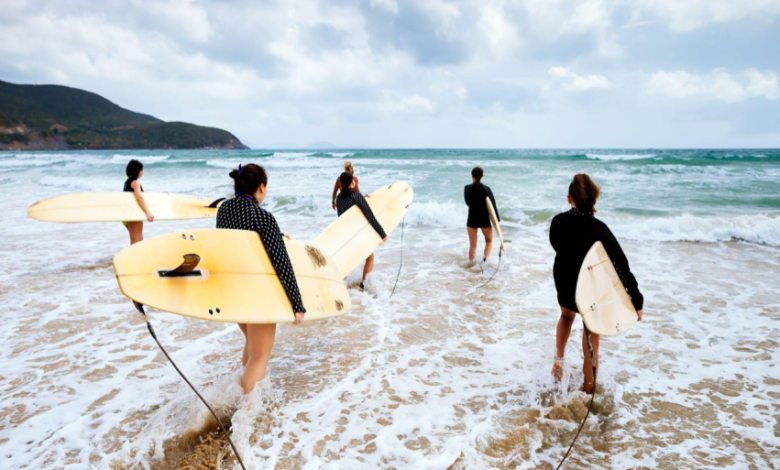Catch Your First Wave: A Beginner’s Guide to Surfing and Gear Selection

Learn the basics of surfing with our complete beginner’s guide. Quickly discover how to surf and start your way to be an expert. This blog post will teach you to choose the proper beginner surfboard to ride your first wave.
Whether taking baby steps on a surfboard or looking to polish your skills, we will help you with our ultimate beginner guide. As you experience the exciting surfing world, our comprehensive gear selection guide will help you surf the waves like a pro.
Having the right gear is crucial before you head out into the water. Here’s what you’ll need:
Getting the Right Surfboard
Ensuring you’re getting the right surfboard for your skill level is essential. Most complete beginners will opt for a foam or soft-top surfboard. These boards are super durable, safe, and easy to maintain – perfect for quickly catching waves and preventing you from injuring yourself when you fall off. Soft-top or foam boards are sturdy and buoyant, making them ideal for beginners as they provide balance and flotation.
As a beginner, the bigger the better. It would help if you aimed for something between 7’0 to 9’0, as the larger size will make catching waves and maneuvering the board much more manageable. Anything smaller than that will be unstable, and anything larger will feel unmanageable. Look for a surfboard in this size range to ensure you can stand up quicker, paddle faster, and improve your surfing skills in every session.
Grab a Surfboard Leash
Gear up with a surfboard leash to contain your board from shooting to the shore when you jump off your wave. It prevents your board from drifting too far away and enhances your safety. A surfboard leash will keep the board close to you, saving you from the tiring journey to retrieve it and potentially cleaning up other surfers out in the water.
Before heading out to the waves, attach a leash to your ankle and the other end to your board. Make sure to get a leash the same size as your board to give you enough length to surf without feeling restricted or getting too wrapped up.
Wear a Wetsuit

Depending on the water temperature, choose an appropriate wetsuit to keep you comfortable and shielded from the elements. The wetsuit you need to buy will depend on the time of year and your climate.
For cooler weather, a full-suit steamer will keep you from feeling the chill. A 3/2mm should do the job for most of the year, but in the dead of winter, you’ll be looking at a 4/3mm.
You can opt for something slightly lighter if you live down south or surf in the warmer months. A 1mm or 2mm spring suit will add that extra layer of neoprene between you and the water, so you can skip the wind chill factor and stay protected from the sun. Otherwise, a rash vest will do fine if it’s warm outside.
Protect It with a Board Bag
Because surfboards vary in size and dimension, searching for a suitable bag may be difficult. You can either have a bag custom-made and fitted for your board or go for a brand with a wide range of surfing bags.
In either situation, you want the bag to be a snug fit and not have your board swinging from side to side inside of it. Put the board inside and enclose it without any hassle.
Apply Surf Wax
Use surf wax on the top of your board to ensure a firm grip and prevent it from slipping. Many beginners need help with the concept of waxing a surfboard. No matter what kind of board you’re riding, you want to ensure more wax than you would think you need under your feet. You can still benefit from waxing up even if you have a soft-top board. You can also opt for a soft-top-specific wax, but any bar of cold water wax will work.
Safety and Beach Awareness for Beginners
Safety should always be your top priority for any water sports activity. Before embarking into the water, educate yourself with these basic safety measures:
- Develop your swimming skills and make sure you are confident in the water before trying to surf.
- Learn the beach signs, flags, and currents. Understand the waves. Familiarize yourself with rip winds and how to escape them if necessary.
- Respect other surfers’ rights of way and adhere to appropriate surfing etiquette to ensure a pleasant experience in the lineup.
Conclusion
As a beginner, you must remember the essential surfing gear and safety reminders before starting. There is no rush in this journey. It begins by selecting the right beginner-friendly surfboard, such as a soft-top or foam board, for stability and buoyancy.
Familiarize yourself with essential surfing gear, including a surf leash to keep your board near, a wetsuit suited for the water temperature, and surf wax for grip. For reliable beginner-friendly surfing gear, buy gears here.


